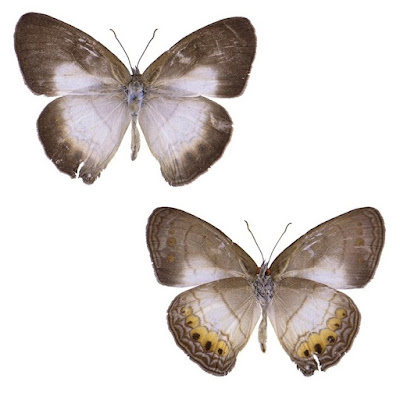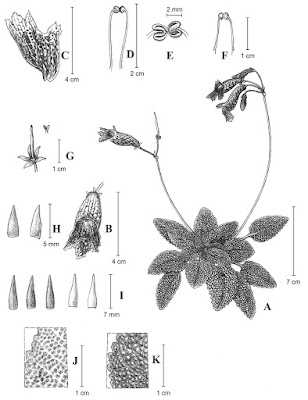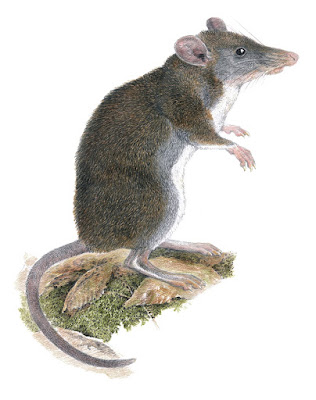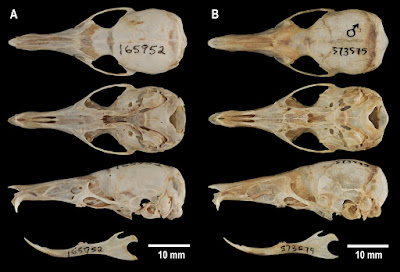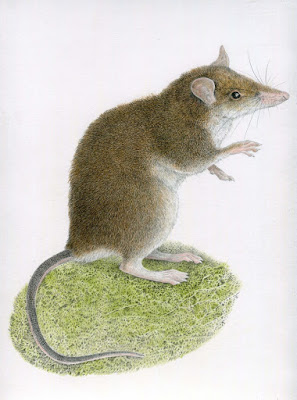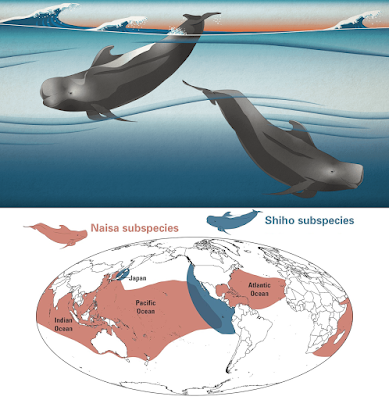[Most Recent Entries] [Calendar View]
Friday, June 7th, 2019
| Time | Event | ||||||||
| 2:09a | [Entomology • 2019] Cristalinaia vitoria • A New and Highly Distinctive Genus and Species of Euptychiina (Lepidoptera: Nymphalidae: Satyrinae) from the Brazilian southern Amazon
Abstract A new genus and species of Euptychiina (Satyrinae), Cristalinaia vitoria Mota, Zacca & Freitas gen. et sp. nov., is described based on three specimens collected in the region of the Cristalino River, Alta Floresta, Mato Grosso, Brazil. This rare species is known only from this region, where it flies inside the dense bamboo patches typical of that area. The last instar larva and the pupa are described; the larva was observed feeding on mature leaves of the common bamboo Guadua aff. paniculata Munro. Keywords: Amazonia, Immature stages, Morphology, Molecular phylogeny, Taxonomy Cristalinaia Freitas, Barbosa & Zacca gen. nov. Type species. Cristalinaia vitoria Mota, Zacca & Freitas sp.n. Diagnosis. Cristalinaia gen. nov. differs from all other genera of Euptychiina by the VHW ocelli with very broad orange ocellar rings, reduced black ocelar spots with no pupils (Fig. 1C) and the male 8th abdominal tergite strongly sclerotized, except by the unsclerotized antero-dorsal region (Fig. 4B, C). The female is unknown. Etymology. The generic name is derived from the Cristalino River, a river of dark translucent waters near which the specimens were collected (the word “cristalino” is Portuguese for “crystal clear”, alluding to the translucent waters of the river). It also alludes to the Reserva Particular do Patrimônio Natural Cristalino (Cristalino Private Reserve) and to the “Fundação Ecológica Cristalino” (Cristalino Ecological Foundation), both founded by Vitoria da Riva Carvalho. The gender of the name should be considered feminine.
Cristalinaia vitoria Mota, Zacca & Freitas sp. nov. Diagnosis. Cristalinaia vitoria sp. nov. superficially resembles several other species of Euptychiina (e.g. Pareuptychia species, Pseudeuptychia species, Splendeuptychia toynei Willmott & Hall, 1995, S. aurigera (Weymer, [1911]), S. triangula (Aurivillius, 1929)) by the white ground color on the wings, but it can be easily distinguished from them by the incomplete median line and four tiny ocelli from M1 to CuA2 on the VFW, by the five VHW ocelli between M1 to 2A that have a very broad orange ocellar ring and black ocellar spot in the distal half of ring plus a very small ocelli in Rs-M1, and the broadened VHW reddish brown marginal line forming crescents in each cell. Distribution. Cristalinaia vitoria sp. nov. is known only from its type locality in the region of Cristalino Lodge, Alta Floresta, northern Mato Grosso. The site is a private protected area (the “Reserva Particular do Patrimônio Natural Cristalino”). Etymology. The specific name is after Vitoria da Riva Carvalho, in recognition of her pioneering work on the conservation of the southern Amazon, and founder of the Cristalino group (which includes the “Fundação Ecológica Cristalino”, Cristalino Lodge and Cristalino Private Natural Heritage Reserves). The specific epithet should be considered feminine and indeclinable in accordance to the Article 31.2.3 (ICZN, 1999). André V.L. Freitas, Luísa L. Mota, Thamara Zacca and Eduardo P. Barbosa. 2019. Description of A New and Highly Distinctive Genus and Species of Euptychiina (Lepidoptera: Nymphalidae: Satyrinae) from the Brazilian southern Amazon. Revista Brasileira de Entomologia. In Press. DOI: 10.1016/j.rbe.2019.05.004 | ||||||||
| 3:49a | [Botany • 2019] Oreocharis odontopetala (Gesneriaceae) • A New Species from Guizhou, China
Abstract A new species, Oreocharis odontopetala Q.Fu & Y.Q.Wang from Guizhou Province in southwest China, is described and illustrated, based on morphological comparison with existing species. It is morphologically most similar to O. elegantissima, but can be easily distinguished by its adaxially bullate leaf blade, abaxially conspicuous reticulate veinlets, brown-purple peduncles, triangular adaxial corolla lobes and abaxial corolla lobe margins bearing 4–10 long teeth, glabrous style and shorter stamens with confluent thecae at the apex, as well as leaf epidermal characters. Keywords: Briggsia, endemism, leaf epidermis, morphology, new taxon, taxonomy Oreocharis odontopetala Q.Fu & Y.Q.Wang, sp. nov. Diagnosis: Oreocharis odontopetala is most similar to O. elegantissima, having a similar shape of leaf blade, lanceolate sepals and bracts, stellate ring-like disc, pistil and fruits. Oreocharis odontopetala differs from O. elegantissima by its adaxially bullate leaf blade (vs. not bullate), with abaxially reticulate veinlets conspicuous (vs. veinlets inconspicuous); peduncles brown-purple (vs. green); adaxial corolla lobes triangular (vs. oblong) and abaxial corolla lobe margins with 4–10 long teeth (vs. margin nearly entire); style glabrous (vs. glandular pubescent) and stamens shorter (adaxial 0.5–1.4 vs. 2.0–2.6 cm, abaxial 0.8–1.8 vs. 2.3–2.7 cm) with confluent thecae at apex (vs. not confluent). ... Etymology: The species is named after its abaxial strongly toothed corolla lobes. Vernacular name: Chǐ Bàn Cū Tǒng Jǜ Tái (Chinese pronunciation); 齿瓣粗筒苣苔 (Chinese name). Qiong Fu, Ying Xia, Ying Guo, Rong Huang and Ying-Qiang Wang. 2019. Oreocharis odontopetala, A New Species of Gesneriaceae from Guizhou, China. PhytoKeys. 124: 1-9. DOI: 10.3897/phytokeys.124.34609 | ||||||||
| 2:14p | [Mammalogy • 2019] Rhynchomys labo & R. mingan • Two New Species of Shrew-rats (Rhynchomys: Muridae: Rodentia) from Luzon Island, Philippines
Abstract The murine genus Rhynchomys includes the large-bodied Philippine “shrew-rats,” highly specialized members of the vermivorous clade of Philippine murids. Four species are recognized, all of which are endemic to Luzon Island: R. soricoides from mountains within the Central Cordillera, R. isarogensis from Mt. Isarog on the Bicol Peninsula, R. banahao from Mt. Banahaw in south-central Luzon, and R. tapulao from Mt. Tapulao in the Zambales Mountains. Field surveys in 2006 and 2008 revealed two additional populations of Rhynchomys, one from Mt. Labo (1,544 m), a dormant stratovolcano at the base of the Bicol Peninsula, the other from Mt. Mingan (1,901 m), the highest peak in the central Sierra Madre of east-central Luzon. Assessment of external and craniodental features of available specimens from throughout Luzon support our description of the populations on Mt. Labo and Mt. Mingan as new species. All species of Rhynchomys are restricted to high-elevation, montane, and mossy forest habitats, separated by intervening lowlands. These discoveries highlight the importance of isolated highland areas in the historical diversification of Southeast Asian murines, and as current centers of endemism. biogeography, Chrotomyini, conservation, distribution, ecology, morphology, oceanic islands, systematics
Rhynchomys labo, new species Labo shrew-rat Rhynchomys sp.: Balete, Heaney, Alviola, and Rickart, 2013a:71. Rhynchomys isarogensis: Heaney, Balete, and Rickart, 2016:160. Etymology.— The new species is named for Mt. Labo, where the specimens originated. The specific epithet is used as a noun in apposition. We propose “Labo shrew-rat” as the English common name. Distribution.— Known only from forested areas on the north slope of Mt. Labo between 1,250 and 1,413 m elevation.
Rhynchomys mingan, new species Mingan shrew-rat Rhynchomys sp.: Balete, Alviola, M. R. M. Duya, M. V. Duya, Heaney, and Rickart 2011:80. Rhynchomys sp.: Heaney, Balete, and Rickart, 2016:163. Etymology.— The new species is named for the Mingan Mountains where the specimens originated. The specific epithet is used as a noun in apposition. We propose “Mingan shrew-rat” as the English common name. Distribution.— Known only from localities in old-growth montane and mossy forest on the southwestern slope of Mt. Mingan between 1,476 and 1,785 m elevation. Eric A. Rickart, Danilo S. Balete, Robert M. Timm, Phillip A. Alviola, Jacob A. Esselstyn and Lawrence R. Heaney. 2019. Two New Species of Shrew-rats (Rhynchomys: Muridae: Rodentia) from Luzon Island, Philippines. Journal of Mammalogy. gyz066. DOI: 10.1093/jmammal/gyz066 New Species Discovered in Philippines Two new species of ‘tweezer-beaked hopping rats’ discovered in Philippines @nhmu sciglow.com/other/two-new-species-of-twe | ||||||||
| 2:43p | [Cetacea • 2019] Globicephala macrorhynchus • Oceanographic Barriers, Divergence, and Admixture: Phylogeography and Taxonomy of Two Putative Subspecies of Short‐finned Pilot Whale
Genomic phylogeography plays an important role in describing evolutionary processes and their geographic, ecological, or cultural drivers. These drivers are often poorly understood in marine environments, which have fewer obvious barriers to mixing than terrestrial environments. Taxonomic uncertainty of some taxa (e.g., cetaceans), due to the difficulty in obtaining morphological data, can hamper our understanding of these processes. One such taxon, the short‐finned pilot whale, is recognized as a single global species but includes at least two distinct morphological forms described from stranding and drive hunting in Japan, the “Naisa” and “Shiho” forms. Using samples (n = 735) collected throughout their global range, we examine phylogeographic patterns of divergence by comparing mitogenomes and nuclear SNP loci. Our results suggest three types within the species: an Atlantic Ocean type, a western/central Pacific and Indian Ocean (Naisa) type, and an eastern Pacific Ocean and northern Japan (Shiho) type. mtDNA control region differentiation indicates these three types form two subspecies, separated by the East Pacific Barrier: Shiho short‐finned pilot whale, in the eastern Pacific Ocean and northern Japan, and Naisa short‐finned pilot whale, throughout the remainder of the species' distribution. Our data further indicate two diverging populations within the Naisa subspecies, in the Atlantic Ocean and western/central Pacific and Indian Oceans, separated by the Benguela Barrier off South Africa. This study reveals a process of divergence and speciation within a globally‐distributed, mobile marine predator, and indicates the importance of the East Pacific Barrier to this evolutionary process. Keywords: cetacean, Globicephala macrorhynchus, phylogeography, population structure, taxonomy
Amy M. Van Cise, Robin W. Baird, Charles Scott Baker, Salvatore Cerchio, Diane Claridge, Russell Fielding, Brittany Hancock‐Hanser, Jacobo Marrero, Karen K. Martien, Antonio A. Mignucci‐Giannoni, Erin M. Oleson, Marc Oremus, M. Michael Poole, Patricia E. Rosel, Barbara L. Taylor and Phillip A. Morin. 2019. Oceanographic Barriers, Divergence, and Admixture: Phylogeography and Taxonomy of Two Putative Subspecies of Short‐finned Pilot Whale. Molecular Ecology. DOI: 10.1111/mec.15107 New Sub-species of Pilot Whale Identified in Pacific Ocean WHOI.edu/press-room/news-release/study-ident |
| << Previous Day |
2019/06/07 [Calendar] |
Next Day >> |
